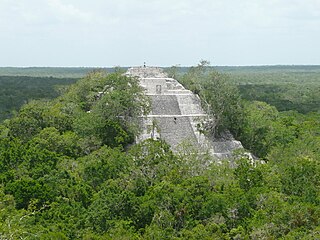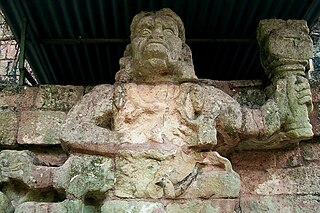
Copán is an archaeological site of the Maya civilization in the Copán Department of western Honduras, not far from the border with Guatemala. It was the capital city of a major Classic period kingdom from the 5th to 9th centuries AD. The city was in the extreme southeast of the Mesoamerican cultural region, on the frontier with the Isthmo-Colombian cultural region, and was almost surrounded by non-Maya peoples.
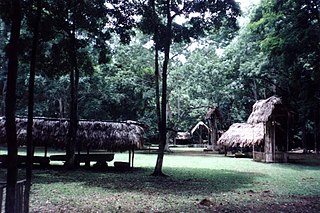
Dos Pilas is a Pre-Columbian site of the Maya civilization located in what is now the department of Petén, Guatemala. It dates to the Late Classic Period, being founded by an offshoot of the dynasty of the great city of Tikal in AD 629 in order to control trade routes in the Petexbatún region, particularly the Pasión River. In AD 648 Dos Pilas broke away from Tikal and became a vassal state of Calakmul, although the first two kings of Dos Pilas continued to use the same emblem glyph that Tikal did. It was a predator state from the beginning, conquering Itzan, Arroyo de Piedra and Tamarindito. Dos Pilas and a nearby city, Aguateca, eventually became the twin capitals of a single ruling dynasty. The kingdom as a whole has been named as the Petexbatun Kingdom, after Lake Petexbatún, a body of water draining into the Pasión River.

Yax Nuun Ahiin I, also known as Curl Snout and Curl Nose, was a 4th-century ruler of the Maya city of Tikal. His name when transcribed is YAX-?-AH:N, translated "First? Crocodile". He took the throne on September 12, 379, and reigned until his death. He is referred to by the Mayan title ajaw, meaning lord.

Yikʼin Chan Kʼawiil also known as Ruler B, Yaxkin Caan Chac and Sun Sky Rain,, was an ajaw of the Maya city of Tikal. He took the throne on December 8, 734.

Bʼalaj Chan Kʼawiil was a Maya ruler of Dos Pilas. He is also known as Ruler 1, Flint Sky God K and Malah Chan Kʼawil.
Jasaw Chan K'awiil is the modern deciphered transliteration of a personal name glyph appearing in pre-Columbian Maya inscriptions. It may refer to:
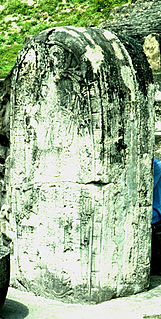
Jasaw Chan Kʼawiil II also known as Stela 11 Ruler,, was an ajaw of the Maya city of Tikal. He ruled c.869. The monuments associated with Jasaw Chan Kʼawiil II are: Stela 11 and Altar 11.

The known rulers of Tikal, a major centre of the Pre-Columbian Maya civilization in modern-day Guatemala:

Sihyaj Chan Kʼawiil II, also known as Storm Sky and Manikin Cleft Sky, was an ajaw of the Maya city of Tikal. He took the throne on November 26, 411 and reigned until his death. He was a son of his predecessor Yax Nuun Ahiin I and Lady Kʼinich, and a grandson of Spearthrower Owl. Stela 31, erected during his reign, describes the death of his grandfather in 439; other monuments associated with Sihyaj Chan Kʼawiil II are Stelae 1 and possibly Stelae 28. Tikal Temple 33 was Sihyaj Chan Kʼawiil II's funerary pyramid and his tomb was located beneath it.
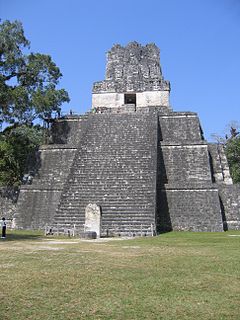
Lady Lahan Unen Moʼ also known as Lady 12 Baby Macaws and Kalajuun Uneʼ Moʼ was a Maya queen of Tikal as a wife of ajaw Jasaw Chan Kʼawiil I. She was the mother of ajaw Yikʼin Chan Kʼawiil. She died in c.704.

Yuknoom Yichʼaak Kʼahkʼ ) or Yuknoom Ixquiac was a Maya king of the Kaan kingdom, which had its capital at Calakmul during the Classic Period of Mesoamerican chronology.

Lady of Tikal, also known as Woman of Tikal, was a queen of the Mayan city of Tikal. She took the throne on April 19, 511 and reigned until about 527.

The North Acropolis of the ancient Maya city of Tikal in Guatemala is an architectural complex that served as a royal necropolis and was a centre for funerary activity for over 1300 years. The acropolis is located near the centre of the city and is one of the most studied of Maya architectural complexes. Excavations were carried out from 1957 to 1969 by the University of Pennsylvania, directed by Edwin M. Shook and William Coe.
Chan Imix Kʼawiil was the twelfth ruler of the Maya city state Copán. His nickname was Smoke Jaguar.

Kʼakʼ Yipyaj Chan Kʼawiil was a ruler of the Mayan city of Copán. He was the son of Kʼakʼ Joplaj Chan Kʼawiil. The early period of his rulership fell within Copán's hiatus but later on he began a programme of renewal in an effort to recover from the earlier disaster of the city. He built a new version of Temple 26, with the Hieroglyphic Stairway being reinstalled on the new stairway and doubled in length. Five life-size statues of seated rulers were installed seated upon the stairway. Kʼakʼ Yipyaj Chan Kʼawiil died in the early 760s and is likely to have been interred in Temple 11, although the tomb has not yet been excavated.

Sihyaj Chan Kʼawiil I, was ajaw ("lord") of the Maya city-state of Tikal. He was son of his predecessor Animal Headdress and Lady Skull. The monument associated with Sihyaj Chan Kʼawiil I is El Encanto Stela I.

Wak Chan Kʼawiil, also known as Double Bird, was an ajaw of the Maya city of Tikal. He took the throne on December 27, 537(?) and reigning probably until his death. He was son of Chak Tok Ichʼaak II and Lady Hand. He sponsored accession of Yajaw Teʼ Kʼinich II, ruler of Caracol in 553. The monument associated with Wak Chan Kʼawiil is Stelae 17.






